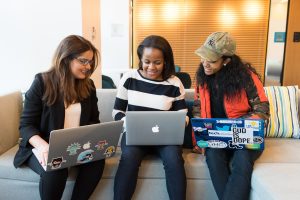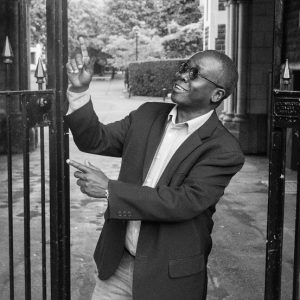EdTech Blog
Feature Blog

Educational Technology – Empowering Students’ Writing and Identity
As a social linguist, Jasbir Singh is passionate about helping students write in a way that truly reflects their unique voice and identity. Through is research, Jasbir explored the role of educational technology in assisting students in their writing, seeking to capture and understand the technological tools that students use to express themselves. Despite not being a “techie” person, Jasbir’s PhD studies pushed him to delve into the world of educational technologies.
More Blogs
Peer Scaffolding
"Can students learn a lot from their peers? Yes, they can."
Non-institutional Technologies
“I hope that we can stop creating resources and instead signpost to existing resources that provide a solution”
Research Methodologies - More than a Means to an End
“It is not only about learning the methods; you can become a creator of the methods and techniques.”
Online Dexterity
"We wanted to use this project to define 'online dexterity', we know it has something to do with being flexible, adaptable and malleable."
Associate Professor Joyce Koh
"Teaching introduced me to new perspectives which caused me to consider the design of my own lessons"
Digital Transformation in a University Context
"I’m interested in how technology transforms the teacher, enabling them to think differently.”
Big Data and Higher Education
With the right systems and structures in place, big data has the potential to transform higher education.
Educational Technology - Empowering Students' Writing and Identity

As a social linguist, Jasbir Singh is passionate about helping students write in a way that truly reflects their unique voice and identity. Through his research, Jasbir explored the role of educational technology in assisting students in their writing, seeking to capture and understand the technological tools that students use to express themselves. Despite not being a “techie” person himself, Jasbir’s PhD studies pushed him to delve into the world of educational technologies.
Traditionally, text matching software such as Turnitin had been used by teachers to catch plagiarism, which in turn led students to find alternative ways to circumnavigate these challenges. This resulted in the technology being used as a tool to police students’ work, rather than as an ally in their creative expression. However, Jasbir’s research revealed that paraphrasing bots like Grammarly were helping students refine their work, providing clarity and addressing tone, which led to increased confidence in producing their authentic selves on paper.
By using educational technologies in this way, the focus shifts from punitive measures to empowering students in their ability to articulate themselves. Jasbir believes that technology can go beyond correcting spelling and grammar. It can actually address a student’s emotional connection to their writing. For example, a software could ask, “How are you feeling about this piece of writing? Does it truly reflect you?”
Inspired by these findings, Jasbir developed software that helps students find their authoritative voice and use it confidently. While he initially questioned whether there was a need for such technology, his doubts were dispelled with the arrival of artificial intelligence language models like ChatGPT, which exploded onto the internet in late 2022. ChatGPT is the perfect example of what Jasbir argued for in his literature review: there is a need for technology that empowers students in their writing confidence, and a healthy injection of philosophy and humanities is required in the field of educational technologies. This confirms that there is a vital role for social linguists like Jasbir to assist in navigating the incoming wave of artificially intelligent educational technologies.
Jasbir’s research points to the potential of educational technology to be a powerful ally in empowering students’ writing and identity, rather than a tool for policing their work. With a focus on students’ emotional connection to their writing, technology can be used to support students’ unique voices and empower them to express themselves confidently. Jasbir’s research and developments in this area are essential in guiding the field of educational technologies towards a more positive and empowering future.
Peer Scaffolding

Mary Rui Ma has been investigating how social media apps could assist Chinese students with learning English. Based on the ‘English Corner’ initiative found commonly in Chinese universities, Mary wanted to see if this in-person social learning space could be replicated online. “Students are on their phones 24/7 and although social media tools are not designed for learning, what if I can use them to help them learn English?”
In 2023 Mary completed projects at two different universities using the social media app WeChat as an environment for learning. The first group of students were less proficient in English and needed encouragement to work in a collaborative manner. “Peer scaffolding is collaborative learning” Mary shared, “these students didn’t know each other, and I had to remind them to show care for others and not concentrate solely on what they were talking about.” The second group of students were more advanced in their proficiency of English. “They also didn’t know each other but they showed concern for each other, which is crucial for collaborative learning.”
There were many aspects that had to be considered when designing the project. Mary had originally intended to use WeChat for the learning sessions and a different platform, QQ, for their homework, but the students were keen to keep everything on one platform. She had also planned to offer 2-hour sessions but hesitantly decreased the time to an hour or half hour sessions. “I thought it might be too short, but the students were quite excited because it didn’t feel like a burden. Human attention is quite a valuable resource, especially online.”
To recruit the students to her project she had to consider what it could offer that would be of benefit to them. “The undergraduates find it hard to write academic essays and so this was a chance to talk about the topics and discuss.” The design of her intervention study was also very important. Essentially it was an English Corner functioning via the platform WeChat. She gave the students space to discuss problems first before sharing her own viewpoint which they were free to agree or disagree with. “The intervention study was exploring how students could learn from their peers by sharing their ideas with each other.”
It was important to Mary to create an environment that lowered the students’ anxiety. She was careful not to position herself as a teacher in her online English Corner because a teacher is a highly respected role in Asian culture and likely to affect how the students related to her. “I let them know that I wasn’t their English teacher, I wasn’t an authority, I told them their viewpoint is respected by me.” It was through this discussion and discourse that students were able to practice critical thinking and appreciate how they could all think about the same problem in different ways. “They were critical from day one and at one point I wasn’t sure they would turn up the next day.”
Mary is at the analysis stage of her research but some there are already some key findings coming to light. The first was a gap in the literature when it came to the concept of ‘peer scaffolding’. “It’s a terminology that’s interpreted differently by scholars from different fields. It’s used quite a lot in educational studies but not so much in applied linguistics[i].” Feedback from her students has already indicated that they learned a lot via the projects and that social media platforms like WeChat could play a role in providing a less pressurised environment for learning. “For me, as university teacher and as a mum I have learned a lot from this project. Can students learn a lot from their peers? Yes, they can. Sometimes it’s emotional learning, sometimes it’s peer encouragement and sometimes they just feel better understood by their peers. That’s important, it warms the heart.”
[i] Deeply rooted socio-cultural theory, the term scaffolding was first coined and defined in Wood, Bruner and Ross’s (1976) study of adult-child interaction during problem-solving tutoring sessions (Nancy, 2012). The value of “scaffolding” lies in the fact that it allows us to see the dialogic nature of a particular type of interaction, in which the more expert interlocutor provides guidance that is calibrated to the specific needs of the learner engaging with a specific task (Jenefer Philp, 2016). Specifically, in a L2 learning and in places where chances of being exposed to foreigners are limited, promoting scaffolding among peers with sufficient support from the teacher is significant and meaningful.
Non-Institutional Technologies

Prior to joining HEDC, Qian’s work centred around eLearning and course designs. Students would sometime come to him to ask questions about accessing and using digital resources. “I would ask them, ‘I developed a nice package for your study modules, did you use it?’ Some students said, “oh yes, it’s nice” and others would say “I barely log into the system, let alone the new package.”
This feedback from the students got Qian thinking about the huge amount of time and resources universities spent on creating things the students might not use. “I spent so much effort developing these packages and the students are telling me they don’t necessarily use them. So, I asked them ‘how are you learning?’” What he found was that students sometimes saw the digital resources provided to them as a hurdle and if they could get away with not using them, they would. “I don’t want to use a huge amount of effort to develop something that students won’t value” Qian shared, “because it’s a waste of my time and a waste of university resources.” He felt that if students are going to YouTube to learn, he’d rather find a really good 5min video and send it to students rather than trying to recreate the video himself.
It’s a notion that challenges typical thinking patterns; beliefs that as new areas of teaching arise university educators must create a new resource to teach students. Or if students are struggling in an area then there is an obligation for educators to develop something to help students learn. “I hope that we can stop creating resources and instead signpost to existing resources that provide a solution” he shares. Even in situations where existing resources only provide part of the information, Qian felt that courses could use them as an introduction and build upon that knowledge base. The reinventing of wheels is apparent in areas of common knowledge. The APA referencing style, for example, is common knowledge and yet many universities have put time and resources into creating their own referencing guides. Taking a shared economy approach to knowledge creation would free educators to engage with their students instead of being locked away re-creating already existing resources.
Qian imagines a world where staff wouldn’t have to worry about creating slides for a one-hour session. They could just send their students a link to a 20min video and ask them to come to the session to talk about the key ideas. “We can even look at videos that are out there conveying incorrect information together with our students, and then discuss the pitfalls of just copying what some random video says.” In this way, students could feel free to explore all the resources available to them while teachers work alongside them, helping them to become independent thinkers who go on to create new knowledge.
This approach to using digital learning tools and resources challenges traditional ideas about universities being experts in content creation. “It’s humbling” Qian shares “when you are their teacher and your students are accessing resources beyond what you give them. It requires a shift in your identity as a teacher.” His research examines how students learn with digital technologies and how teachers can facilitate student learning beyond the tools and resources offered by institutions. “We need to have a better understanding of how students learn. To go where they go and have meaningful conversations with them about that.”
Online Dexterity

When COVID-19 arrived teaching and learning had to be moved online quickly. Applications like Zoom (which has been around since 2013) became an integral tool for teachers and students but not everyone had made use of them until they had to. Associate Professor Joyce Koh used this pivotal time in history to research the concept of ‘Online Dexterity’ – what makes it hard for some teachers to adjust to new technologies while others found it easier to make the shift. “Is the problem just technical in nature?” she questioned, “Is it really just about a lack of technical skills? We wanted to use this project to define ‘online dexterity’, we know it has something to do with being flexible, adaptable and malleable.”
The interviews she completed with Otago University teachers helped to clarify that definition and with the data now in hand, a greater sense of clarity has been achieved in terms of focus and development. “It’s not just about teaching skills, skills are kind of static”, Dr Koh shares, “we are exploring the idea of competencies as dexterities, in that that are alive and manoeuvrable so that you can more easily navigate all sorts of learning environments.”
The research revealed that issue is not merely a teacher problem or a student problem. “We are realising that that effective outcomes will not be achieved by focusing only on students or only on teachers, what’s important is the process of them coming together and what that looks like.” As Dr Koh continues to unpack the concept of Online Dexterity and what it means for both students and teachers. This could take the form of teachers having dexterity to manoeuvre different kinds of online learning modalities and students having dexterity to choose appropriate learning pathways and modalities according to their learning needs. How teachers and students could be better supported to acquire online dexterity would be an area for further research.
Read Joyce’s article on adaptiveness for online learning here.
Research Methodologies - More than a Means to an End

Professor Ben Daniel is passionate about the field of research methodologies and how they are taught. “I want to see tools being developed that make learning about research methods fun because it can be dry, let us face it.” Ben wants to see students going beyond learning about research methodologies so they can complete their projects and instead inspiring them to become the teachers of methodologies and even be the creators of them. “It is not only about learning the methods and techniques of getting from points A to B; you can become a creator of the methods and techniques.”
There was a time when Ben himself asked his professor why he should bother learning about research methods, assuming that this field would not lead to employment when it provided a career. After many years teaching research methodologies, Ben began to look more closely at why students were struggling in this area, “for over a decade, I was thinking, what is wrong with students? I kept blaming them.” Ben embarked on a global research project which saw him surveying I carried out a global study of teachers of research methods working in 139 universities. The goal was to learn what they considered best practices in teaching research methods. Participants came from Australia, Canada, Egypt, India, New Zealand, South Africa, Tanzania, the United Kingdom and the United States. “I analysed the data and…those of us who teach research methodologies have a problem. There is a shared agreement that postgraduate students continue to face significant challenges in learning research methodology because of the way we teach methods papers.” He also found that students are taking methodology classes to finish their research projects, and that is it; it is a means to an end.
Ben wants to see students studying methodologies because they want to master them as a discipline. “If you study creative writing, it is because you want to be a creative writer, not just learning creative writing strategies; that is the learning outcome I want to create for students learning methodologies. Students who want to make research methodologies their profession.” Ben understands the challenge of teaching complex and abstract concepts without students falling asleep. “I want to create programmes on methodologies that are far engaging and rewarding using digital approaches.” He remains steadfast in his mission to encourage students to consider research methodologies as more than a subject you take to reach your goal but a field of mastery. “I never thought I would be teaching research methodologies; I was studying Economics and Computer Science but learning about research methodologies early in my undergraduate programme set me on this path.”
Associate Professor Joyce Koh

When I started teaching instructional design, I found myself reflecting on who I am as a designer. Teaching introduced me to new perspectives which caused me to consider the design of my own lessons and reflect upon my own practice. I asked myself what is good instructional design really? And what can I do to inspire my students? My research in this field gave me a deeper understanding of what it is that makes some teachers push the boundaries to create interesting and exciting lessons while others prefer to stick to what is already working well.
My path to teaching instructional design began in creating training packages and developing e-learning for both corporate and public sectors. When I was working in a corporate environment, I did not have much time to reflect about my practice as I was more consumed with meeting targets so as to ensure product quality, customer satisfaction, and good project cashflow. There was no time to theorise, I was busy solving problems. In academia, however, when you are in teaching, you still must put your problem-solving hat on while the research part of your role pushes you to theorise and reflect on your practice.
I did my masters and PhD in instructional design in the United States, and it was a great experience. I could learn from ‘real’ designers, such as people who designed interfaces for first-generation Apple computers. These are people who designed interesting concepts such as the ‘Oscar the Grouch’ extension for the 0S9. Every time you put a file in the trash can, Oscar would pop up on the screen singing, “I love trash!” The masters’ part of the programme was very practical. I did many real projects with real clients. For example, with a local children’s museum who was shifting from a 1-room to a 2-storey facility, we helped them to reimagine their operations and construct a change management programme. I also did internships at an e-learning company which further enriched my real-world design experiences. The PhD was the academic part. I worked on research projects in an educational systems theory research team. I learnt about higher education teaching by being a teaching assistant. We were given fully autonomy over our classes – from designing the course outline to executing it. It was a wonderful experience.
I then became an academic in Singapore at the National Institute of Education of the Nanyang Technological University for 9 years. I was teaching school teachers to integrate technology into their lessons and what intrigued me was why some were more willing and able to do creative, student-centred teaching than others. Similarly, why were some school teachers not able to change their teacher-centred routines to try new approaches? We’d teach them different theories and tools for technology integration, but they still could not fully design student-centred ways of using technology for their classrooms. These are the problems that cause us to do research, they cause us to think and re-evaluate how we ourselves are teaching and modelling student-centred practices as teachers.
In 2017, I came across a job advertisement for a role at the Higher Education Development Centre (HEDC) at the University of Otago. It seemed interesting and since I’ve always been involved in adult education, I thought that maybe there was something else for me to learn in this area. I didn’t think it would be too different from my previous role because it appeared that there were also courses related to learning theories and educational research in HEDC’s MHEd programme. I was also teaching similar courses. When I came here, I realised that even though the educational theories were the same, the practice of higher education is very different from what I’ve known in the school sector. I also realised just how cold it is in Otago, New Zealand.
In terms of educational technologies, COVID-19 has provided a good opportunity for us to work with people who were previously not so comfortable or excited about technology. Otago teachers started using Zoom and they realised that they couldn’t teach the same way, they had to do things differently to engage with their students. This was when we formalised HEDC’s educational technology workshops as the ‘Technology Enhanced Learning and Teaching’ (TELT) programme. COVID-19 made people interested in exploring new tools and teaching approaches that could help them better reach and engage students.
What’s unique about EdTech is that we have a very dynamic and practical view. We can serve as a bridge in some situations. For example, based on our understanding of teachers’ needs, we can suggest the university to consider supporting tools that may be more user friendly for teachers. We can also help teachers make better use of institutional tools by modelling plausible pedagogical strategies. Our intention is help both parties navigate the caveats and find solutions. We are not an ivory tower, we consider our role to be of service to Otago University staff, mentors to PhD students interested in our field and collaborators with researchers who, like us, are interested in the ever-changing landscape of educational technologies.
Digital Transformation in a University Context

Professor Ben Daniel has been researching and learning about digital transformation and what it means. “I am interested in how digital technologies transform the teacher and the way they teach, enabling them to think differently“ he shares “, and how it transforms the student to learn differently.“ Through his work, he intends to encourage academics to think beyond technology as the artefact, “‘ it is also a process, an approach, and that is something people sometimes forget.“
Digital transformation as a working application is seen more widely in corporate sectors. Though digital systems exist in the academic arena, their application is still, in many ways, a work in progress. “It is a cultural transformation“, Professor Daniel shares, “and there can be resistance.“ But contrary to what many people believe, the resistance to digital transformation in the tertiary sector does not come down to any aspect such as age, “many young people do not know how to engage with digital devices in productive ways.“ Professor Daniel’s research on Digital Transformation shows that a shift is likely to occur slowly as capacity and training for the use of the systems increases. “You cannot expect someone to spend hours reading something on a screen if they have never done that before; naturally, they will print it. People will not sit down and type notes at a lecture without typing skills; there are many moving parts.“
During the COVID-19 lockdowns, universities quickly moved their learning online; the most successful universities have already invested in digital infrastructure and embraced digital transformation. But there were gaps in knowledge and experience when it came to utilising the systems available, which Professor Daniel feels must go hand in hand with the acquisition and installation of technologies. Furthermore, he sees the potential in using artificial intelligence as a tool to learn about the learner to deliver content meaningfully. Greater automation can be confronting for people used to carrying out tasks in a specific way, but he insists that change is coming and will ultimately change how students and teachers think and work. “I can see the power of technology“, he shares, “it inspires me, and I would not be here without it.“
Big Data and Higher Education
Professor Ben Daniel

The field of big data has the potential to revolutionise higher education. With many data sets being collected at different points in a student’s pathway through the university, big data has the potential to provide valuable insights into learning, teaching, and for research. However, there are also challenges that need to be addressed in order to fully leverage the opportunities provided by big data.
One of the key challenges is the way in which data is stored. Universities often use disparate systems that do not necessarily talk to each other, resulting in incomplete or duplicated data, and making data sharing across an institution difficult if not impossible. Further, when systems do not talk to each other, it makes it difficult for researchers to draw comparisons across divisions or between institutions. In addition, there can be barriers to accessing the data that students and researchers need in order to develop data models that could provide greater insights for the institution and inform decision-making.
Privacy is another concern when it comes to accessing large data sets. While identifying information can be removed to allow anonymity, data cannot be used for research purposes if permission wasn’t granted at the time of capture. Furthermore, data that reveals weak areas in a university’s operation could damage the institution’s reputation if it were leaked by journalists or media.
Another challenge when using big data is the potential for biased models. It is important to ensure that the subset of data in which a model is trained represents reality as closely as possible, otherwise the model could make recommendations that are belittling or even stereotype people. Even if the model is accurate, it may not reflect reality and if decisions are made based on such models, the outcomes of the decisions might be misleading or potentially catastrophic.
To address these challenges, there is a need for a consolidated system for collecting and storing data in higher education settings. This could help universities plan for their future, allocate resources efficiently, and allow them to operate proactively rather than responsively. Tools such as data warehouses and systems that harvest, process, and visualise data could help to provide valuable insights into learning, teaching, and research. Data governance framework might also guide the collection, analysis and usage of data responsibly.
In conclusion, while big data has the potential to revolutionise higher education, there are challenges that need to be addressed in order to fully leverage its potential. Universities must work to address issues of data storage, access, and bias, while also investing in tools and technologies that can help them to make sense of the vast amounts of data they collect. With the right systems and structures in place, big data has the potential to transform higher education, making it more efficient, effective, and responsive to the needs of students and society as a whole.